Just two teams are left in the AFCON 2023 tournament: Nigeria, who have made it to Sunday’s final after finishing second in Group A, scoring seven goals in total or 0.98 per 90 and conceding just two or 0.28 per 90 — the best defensive record of any side in the whole tournament — and Ivory Coast, who finished third in Group A, scoring five goals in total or 0.66 per 90 while conceding seven or 0.93 per 90, which is not nearly as impressive as Nigeria’s defensive record.
From this information alone, it would appear as though the honours should be going to Nigeria on Sunday. However, throughout this competition based in Ivory Coast, with the final set to take place in Northern Abidjan’s Olympic Stadium of Ebimpé, it has appeared as though Ivory Coast are indestructible.
Despite all their difficulties in the group stage, including a 1-0 loss to Nigeria and a 4-0 loss to Equatorial Guinea, which resulted in head coach Jean-Louis Gasset being sacked despite the possibility and, indeed, eventual reality that the host nation would still progress to the knockout stages as one of the four best-placed third-place teams from the six groups, they’ve managed to put together a little win streak when it matters most, with victories over Senegal, Mali and the Democratic Republic of Congo to earn their way to the African continent’s showcase football match on Sunday.
So, the reason you’re here and the burning question on keen viewers’ lips: how will this match play out? What can we expect from the participants on the pitch? This tactical analysis piece in the form of a tactical preview will provide answers to those questions as we guide you through both teams’ tactics with analysis of the invincible hosts, Ivory Coast, and their formidable foes, Nigeria.
Predicted lineups
Firstly, with regard to lineups, we can expect Ivory Coast’s interim boss, Emerse Faé, to set his team up in a 4-3-3 shape, which has been the case for most of the tournament.
Yahia Fofana is likely to retain his starting position in goal behind a back four potentially consisting of the returning right-sided duo of Serge Aurier and Odilon Kossounou, along with AS Roma’s Evan Ndicka at left centre-back and Al-Fayha’s Ghislain Konan at left-back, who have pretty much been mainstays throughout AFCON.
Jean Michaël Seri has made the team under Faé more often than Ibrahim Sangaré when it comes to the holding midfield position, so we’d say he has a good chance of staying as Ivory Coast’s starting ‘6’, but this is one of the key decisions the interim boss will be tasked with making before kick-off which could go either way.
What’s more certain is that we’ll probably see Franck Kessié and Seko Fofana slotting in as the two ‘8’s just in front of that holding midfielder in the roles they’ve consistently performed throughout the tournament.
In attack, more key decisions must be made, with several attackers, including Max Gradel, Sébastien Haller, Simon Adingra, Jean-Philippe Krasso, Oumar Diakité, Jérémie Boga, Nicolas Pépé, Jonathan Bamba, Karim Konaté and Christian Kouamé all having played at some stage in the tournament with most of those players doing something notable and making a case for their inclusion in the team.
Specific strategies to face off with Nigeria may come into play with regard to the attackers’ selection. Initially, the most likely attacking trio would appear to be Max Gradel, who has been a key creator during his time on the pitch as well as a strong leader, which will be important in a final, Simon Adingra who returned from injury during the tournament but has linked up with his teammates and proven an electric member of the squad in recent games, and Sébastien Haller up front, with the Borussia Dortmund forward having scored the winner in the semi-final.
With that in mind, the AFCON final has historically been a long game with extra-time and penalties, and we wouldn’t bet against Sunday’s clash being another one of those, so perhaps the experience of Gradel will be saved for later in the game in which case we could perhaps expect Oumar Diakité to start out wide.
Similarly, Haller has completed just one 90-minute match during the tournament, and if he’d be a highly desirable penalty taker should the match go that long, he could be replaced up front by Diakité, Konaté, Krasso or Kouamé.
Brighton and Hove Albion’s Adingra is still yet to complete 90 minutes in AFCON, so he’s another who could start on the bench with a view to coming on as an impact sub later with Bamba or Boga potentially starting on the left.
Again, there are a lot of critical decisions to be made there for Emerse Faé, but it wouldn’t be a shock to see him opt to finish the 90 minutes with that aforementioned trio of Gradel, Haller and Adingra rather than start with them.
As for Nigeria, José Peseiro has settled on a 5-4-1/3-4-3 shape in AFCON, and the continuation of this is pretty much a guarantee for the final.
We can also expect to see Stanley Nwabili starting in goal behind a back three of Semi Ajayi on the right, William Troost-Ekong in the middle and Calvin Bassey on the left.
While we’ve seen some instances of him starting on the left in order for Bright Osayi-Samuel to play on the right, we’d say we’re likely to see Nottingham Forest’s Ola Aina at right wing-back. At the same time, FC Porto’s Zaidu Sanusi provides width on the left, as Fulham’s Alex Iwobi and Brentford’s Frank Onyeka take their regular places in central midfield.
Finally, in attack, we should see Ademola Lookman, Nigeria’s top goalscorer in the tournament, start off the left and Moses Simon on the right, with star striker Victor Osimhen leading the line from the centre.
Things seem more straightforward for the Nigerian coach, though there are still some important decisions to bear in mind, including the potential inclusion of Samuel Chukwueze over Simon on the right, as occurred for Nigeria’s successful group stage meeting with Ivory Coast and the possible inclusion of Osayi-Samuel at right wing-back after he played that role in the semi-final.
Meanwhile, Peseiro also has a lot of strength on the bench in the form of Terem Moffi and Paul Onuachu, both of whom can offer something different up front if needed, as well as Joe Aribo and Raphael Onyedika, who can change things up in midfield, again, depending on what the game calls for.
Ivory Coast in possession vs Nigeria out of possession
Moving on to the tactical analysis portion of this piece, we’ll start with our section focusing on what to expect from Ivory Coast in possession and Nigeria out of possession, as we’d expect to see this for most of the game, as we did in their previous meeting during the tournament which saw Ivory Coast finish with 62.38% of the ball.
I wouldn’t necessarily expect them to have exactly the same proportion of the ball in the final, as they’ve been slightly less possession-heavy under Faé, and the previous encounter between these two teams saw Nigeria holding onto their lead for the majority of the second half, meaning they were more comfortable to sit deeper and invite Ivory Coast forward, opening up space in behind for the attackers to potentially exploit on the counter.
Still, I’d expect Nigeria to approach the game with counterattacking their primary goal, perhaps hoping the home crowd drives Ivory Coast forward and makes them a bit too brave, opening up space behind for The Super Eagles to attack. This will likely see them defending in a more passive manner, with Peseiro’s side having clocked their second-highest PPDA (10.67) of the competition in their group stage clash with Ivory Coast, trailing just the South Africa clash in the semi-final.
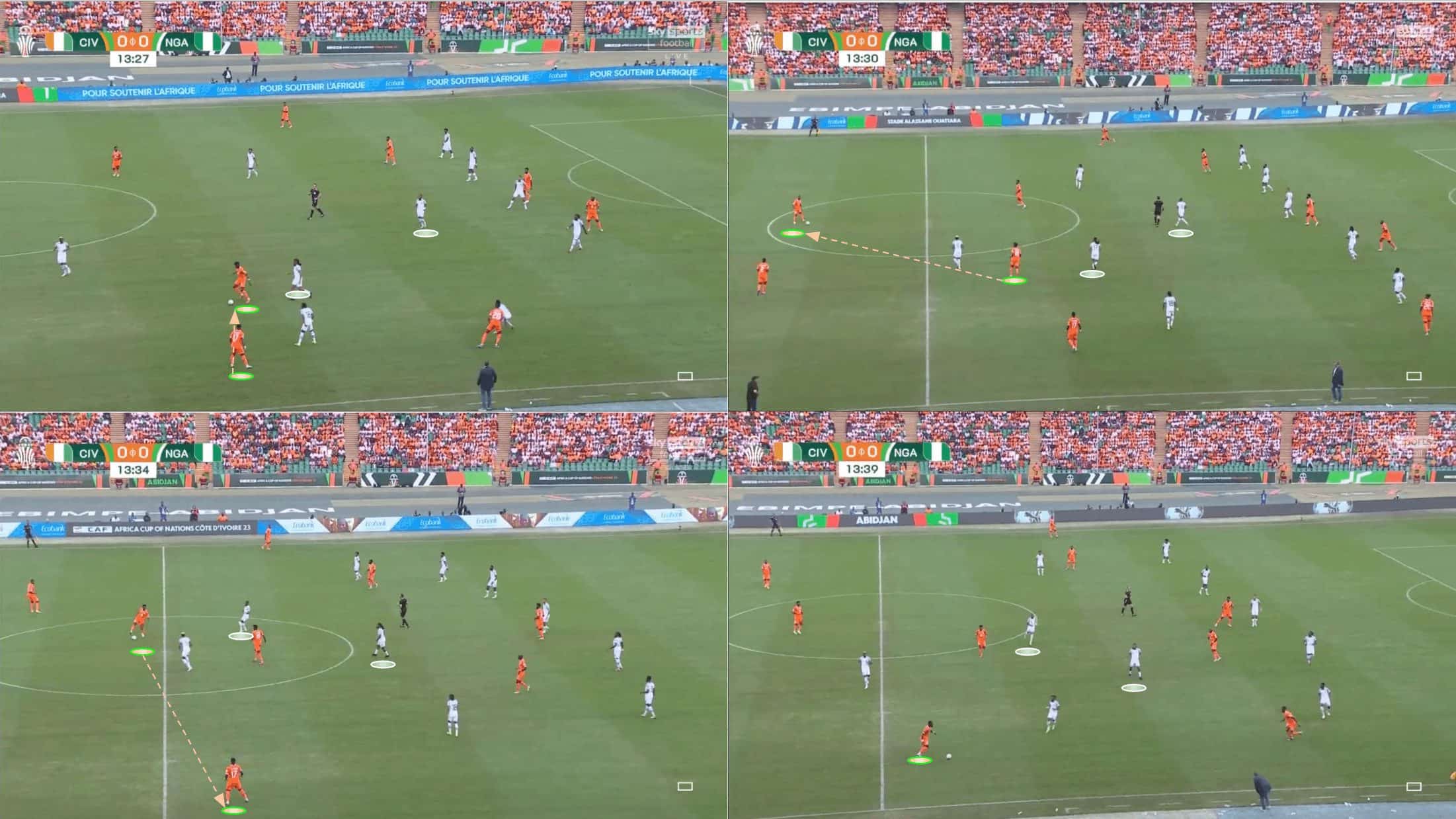
Ivory Coast are quite a patient team in terms of their build-up and ball progression. In the example above, we see them calmly circulate possession as they search for a reliable way through the Nigerian defensive shape. If that safe pathway doesn’t present itself, they’ll keep moving the ball with a view to moving the opposition around and cracking the code to ball progression.
It’s common to see Nigeria operating in a mid-low block as we see in figure 1 and I’d expect to see that fairly often in Sunday’s game. Peseiro’s side don’t press very aggressively, preferring to drop off until the opposition reach about the halfway line. Even then, pressure won’t be very aggressive, and we may just see Nigeria hold their line at this point, looking to frustrate the opposition and potentially force a rushed or risky pass that could allow The Super Eagles to perform an interception and start a counterattack targeting the space open behind the backline.
When the ball is in the centre, we’ll often see Nigeria operating with a flat back five, but when it moves out wide, we’ll see the ball-near wing-back break from the defensive line and apply aggressive pressure to the opposition wide man; in these instances, the wide centre-back on that side must be extra alert to the possibility of a ball being played through in the channel between them and that aggressive wing-back.
Furthermore, the central midfielders will stagger their positioning, with one pressing higher while the other drops off, protecting the space behind them and in front of the backline. We’ll see Onyeka and Iwobi alternating this responsibility based on where the ball is and who’s got easier access to the ball carrier.
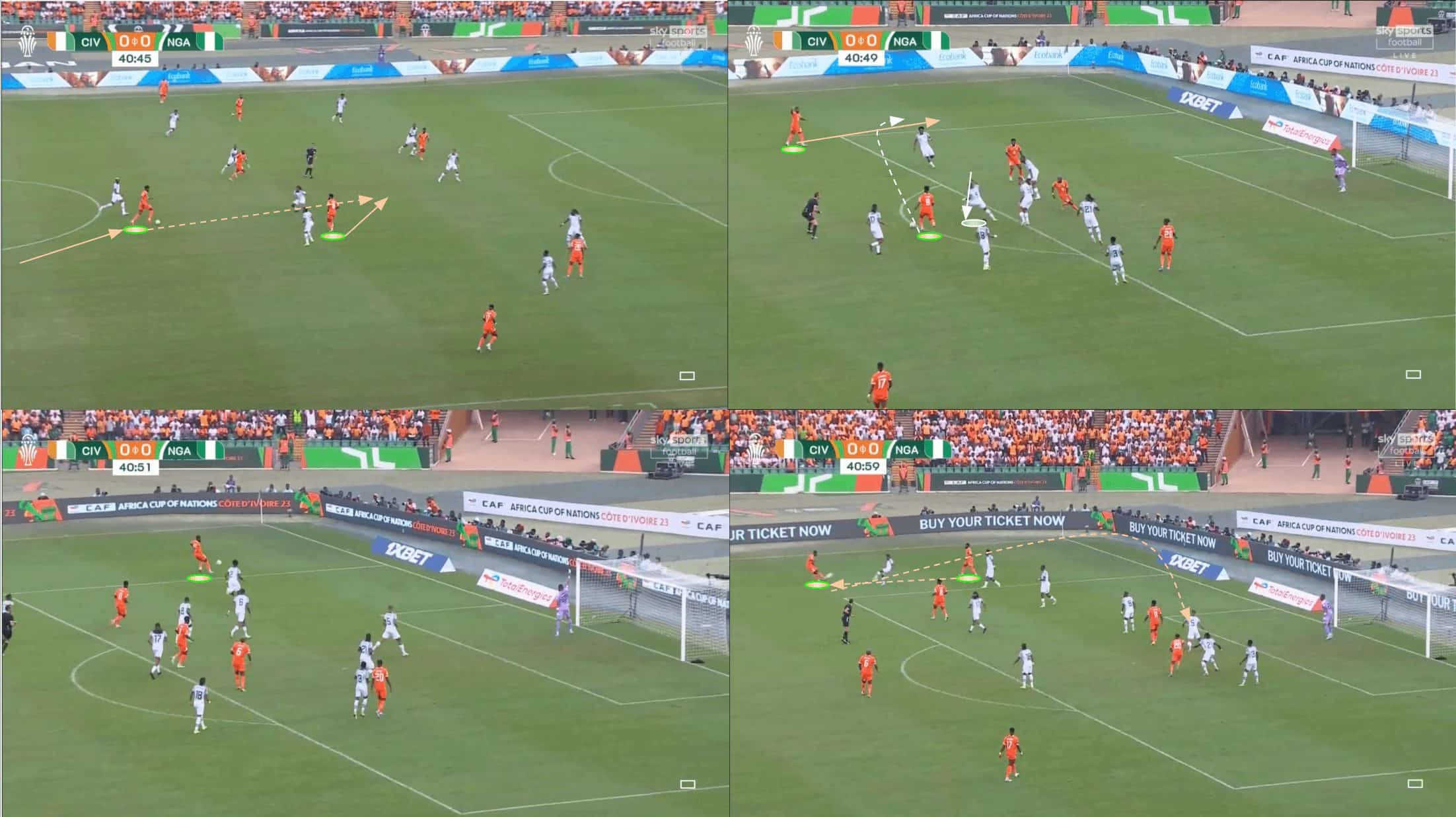
In the progression phase, as seen in figure 1, Ivory Coast’s ‘8’s will advance into the half-spaces while the wingers stay wide. In the chance creation phase, we can expect to see the full-backs advance, too, allowing the wingers more freedom to explore central areas.
Again, this happens very methodically, with the Elephants being very careful about committing too much too soon, especially against a Nigeria side that’s so good exploiting space behind on the counter.
Even as they enter the final third, Ivory Coast will take care with their passing, trying to find a clear path to a goalscoring position but not forcing it if the opportunity doesn’t present itself.
In this case, Nigeria do very well to deny Ivory Coast any way through in the centre of the pitch, forcing the Elephants out wide and deal with the eventual ball in to prevent an easy shot at goal.
Ivory Coast will find it difficult to get in behind Nigeria on Sunday due to their positioning as a slightly deeper backline and centre-backs who are astute at protecting the space behind them.
Their previous game against Nigeria saw Ivory Coast generate their lowest xG (0.68) of the AFCON tournament thus far despite also accumulating the second-most shots (15) they’ve managed in the competition. This is indicative of the way in which Nigeria diligently and expertly defended the most valuable goalscoring positions, forcing Ivory Coast into speculative efforts more and more as desperation crept in later on in the contest, as is the fact that Ivory Coast finished their game against Nigeria with the highest average shot distance (22.75m) of any game they’ve played in AFCON 2023.
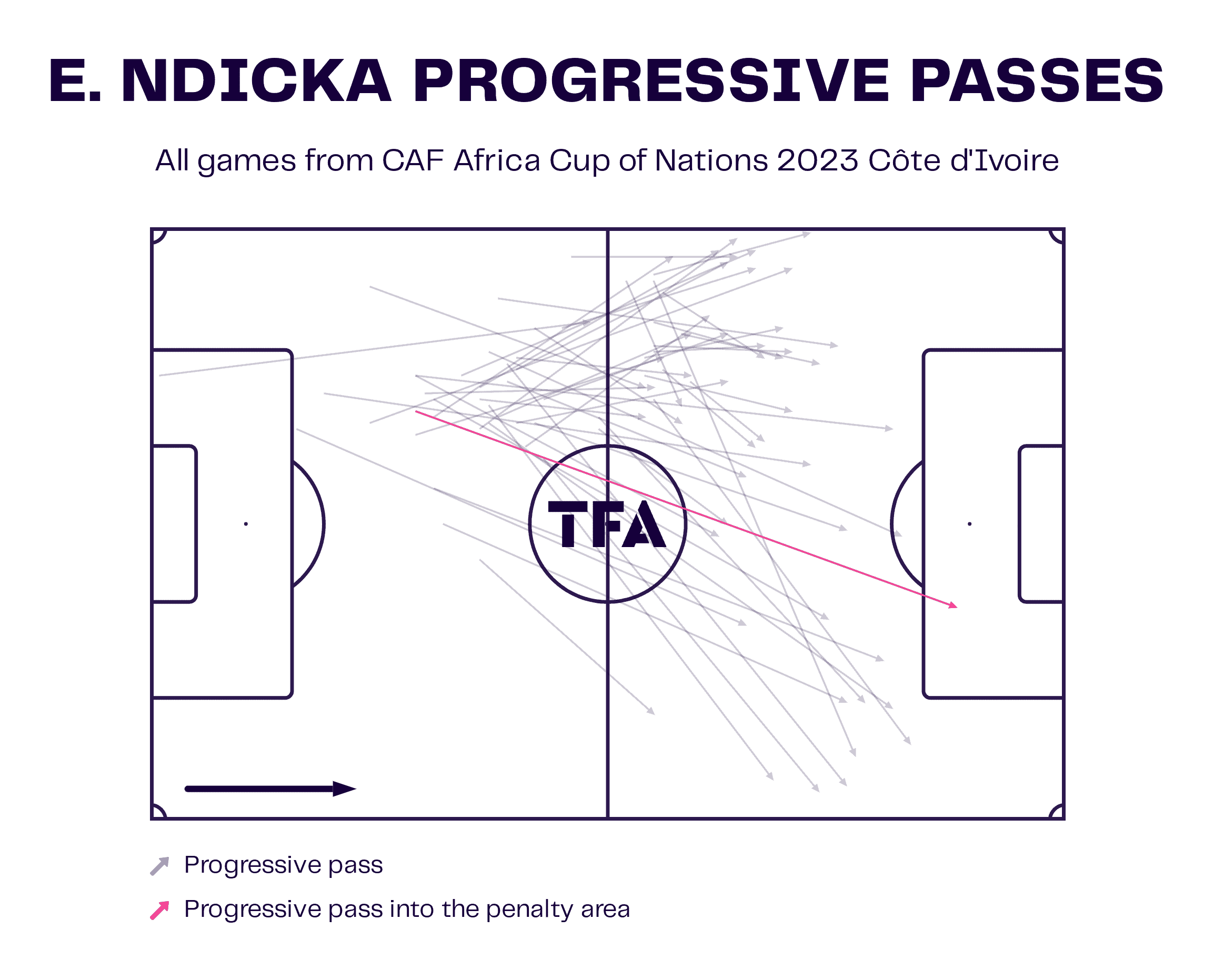
With their full-backs remaining deep until their team enters the final third, they have an important role to play within their team’s progression play — expect Serge Aurier and Ghislain Konan to be firing line-splitting balls upfield as they look to open up Nigeria’s defensive shape on Sunday.
Similarly, Kossounou and Ndicka will play important roles within their team’s ball progression phase. Ndicka, whose progressive pass map for the tournament we see in figure 3, will look to play the winger and central midfielder on his side of the pitch into some space from where they can create higher upfield as well as switch play from left to right to try and isolate the ball-far winger with his full-back to try and create something.
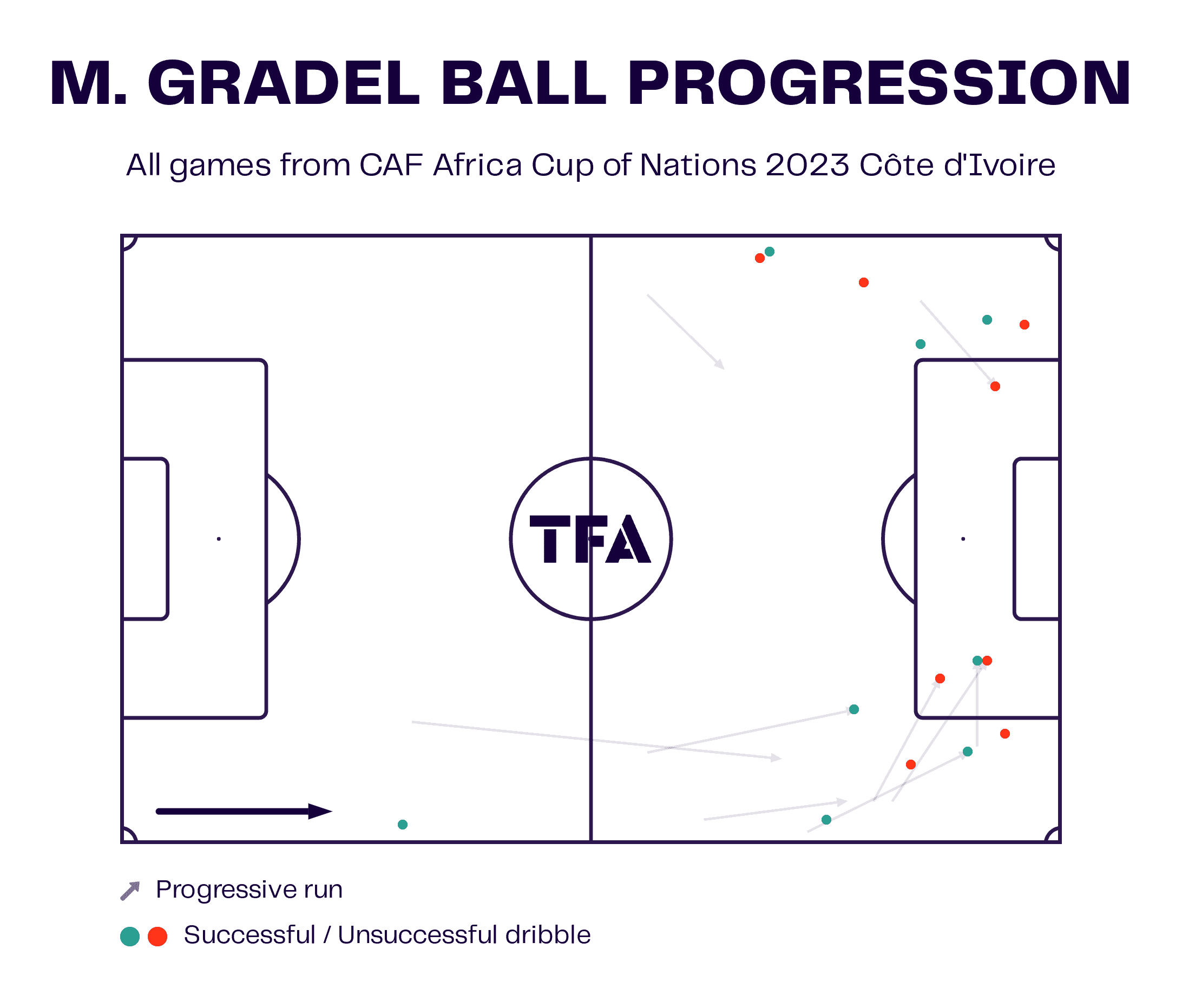
In the final third, expect Ivory Coast’s wingers to provide a dynamic threat from wide, looking to create and win 1v1s to progress towards goal. Gradel has been an effective dribbler and creator from the wings in Ivory Coast’s recent games, playing a key role in his team’s progress to the final.
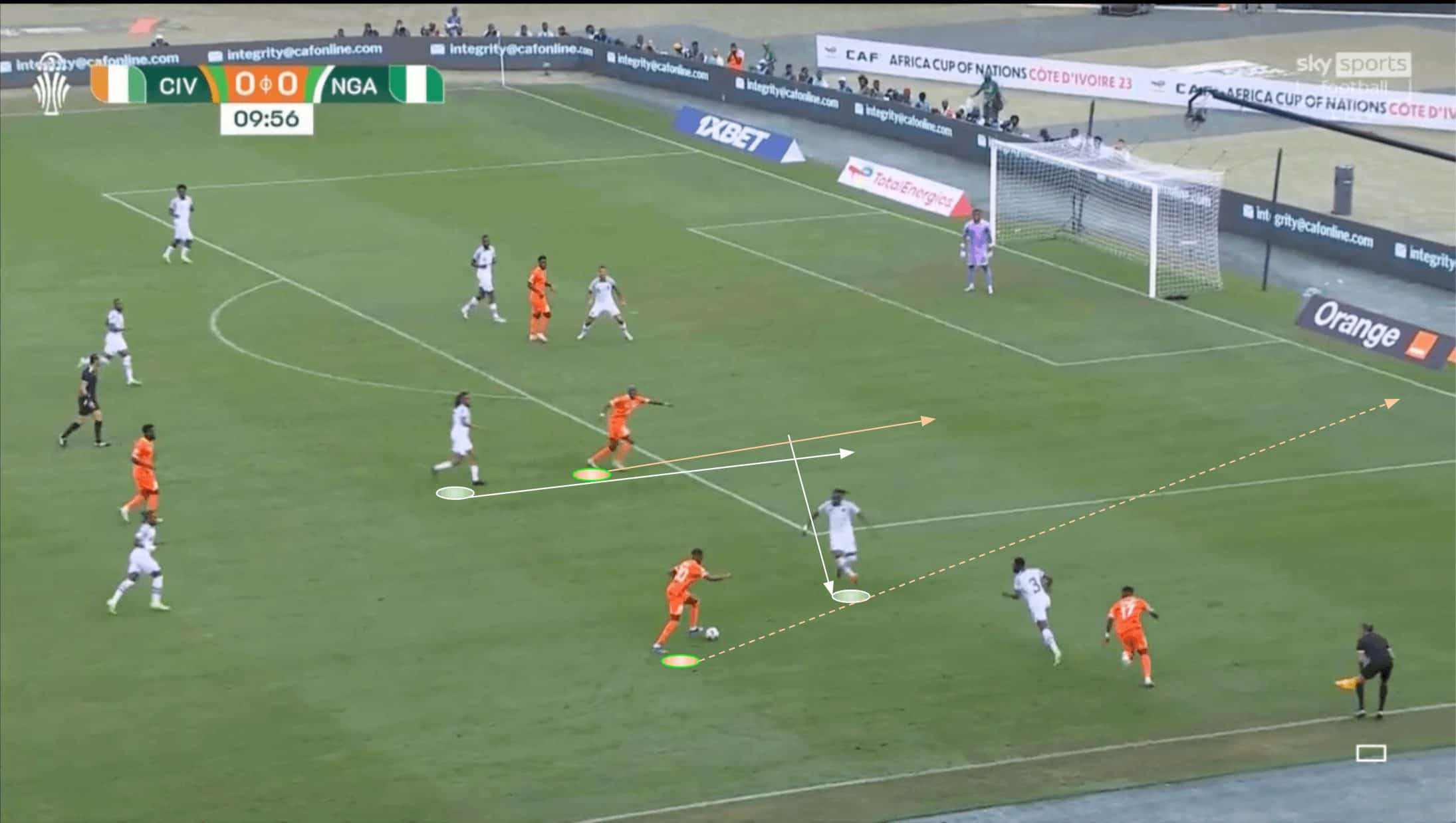
Here, against Nigeria, we see Kouamé receiving just inside the overlapping Aurier, which drags Bassey out from the backline, creating space for another Ivorian player, the advancing ‘8’ Seko Fofana, to move into behind the Nigerian defender — being tracked by Iwobi from midfield.
Kouamé must decide between taking on Bassey himself, playing it through for Aurier or playing it through for Fofana.
In the end, we see Kouamé’s attempted through pass get blocked by the aggressive centre-back, who does very well to end the threat. However, this is the kind of thing Nigeria will have to be alert to in Sunday’s game, as after the wing-back is dragged out, it can spiral into defensive chaos, though that hasn’t really been a big problem for AFCON’s best defensive side in the tournament to date. Still, now is not the time for complacency — they must remain alert.
Nigeria in possession vs Ivory Coast out of possession
Flipping things around, then, let’s take a look at what we can expect from Nigeria in possession versus Ivory Coast out of possession.
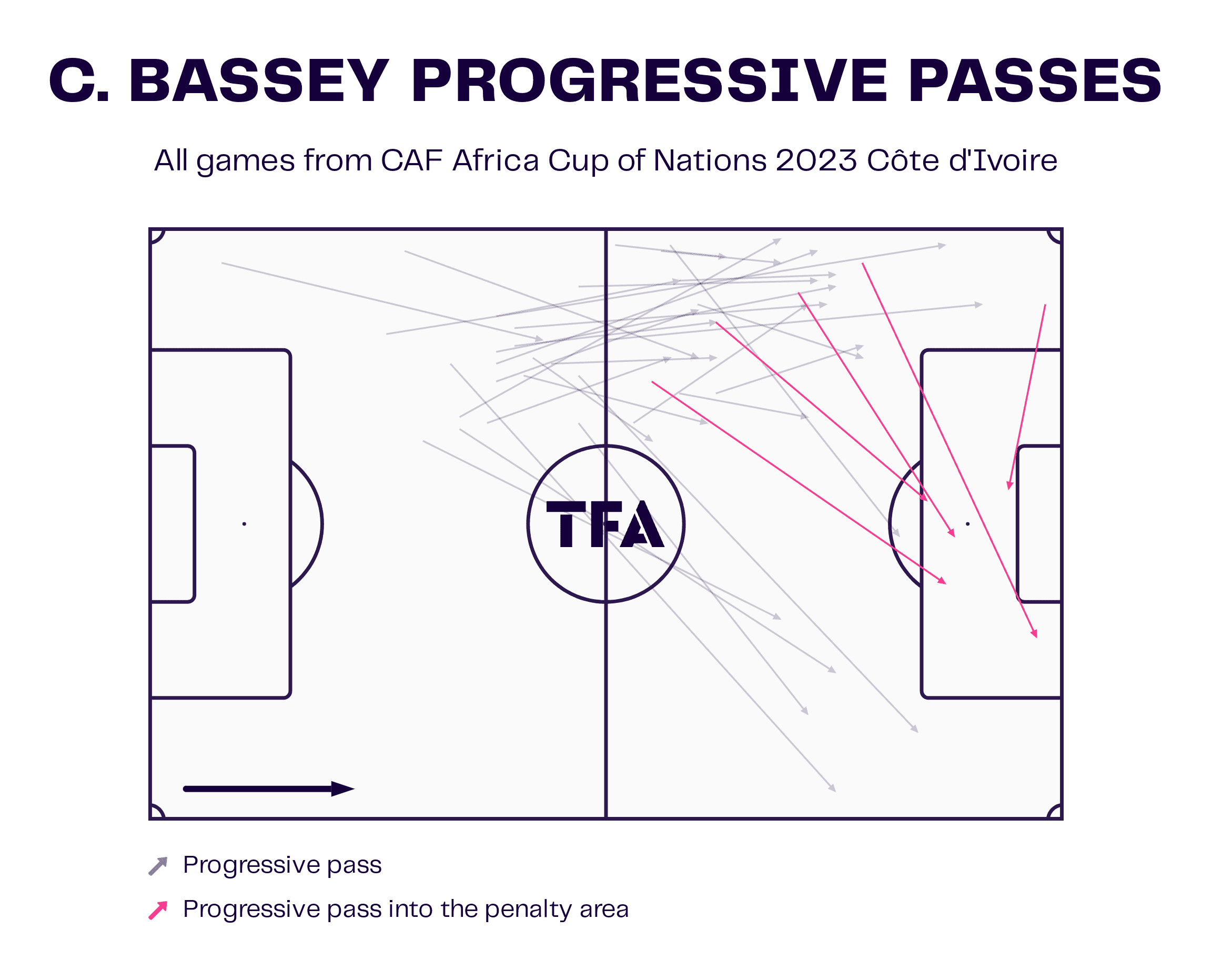
Firstly, like Ivory Coast and their left centre-back, a lot of Nigeria’s progressive passing will come from that position via Fulham’s Calvin Bassey, formerly of Scottish Premiership’s Rangers and Eredivisie’s Ajax.
The Elephants will be looking to target this with their pressing to deny Bassey a chance to hurt them via his progressive passing. It’s notable that Bassey will get a lot higher than Ndicka got and look to create as well as progress, with some crosses from deep into the box visible on figure 6 — watch out for Bassey receiving deep and carrying the ball forward into space, either putting himself in a good position for chance creation or attracting pressure that frees up a teammate in a good position.
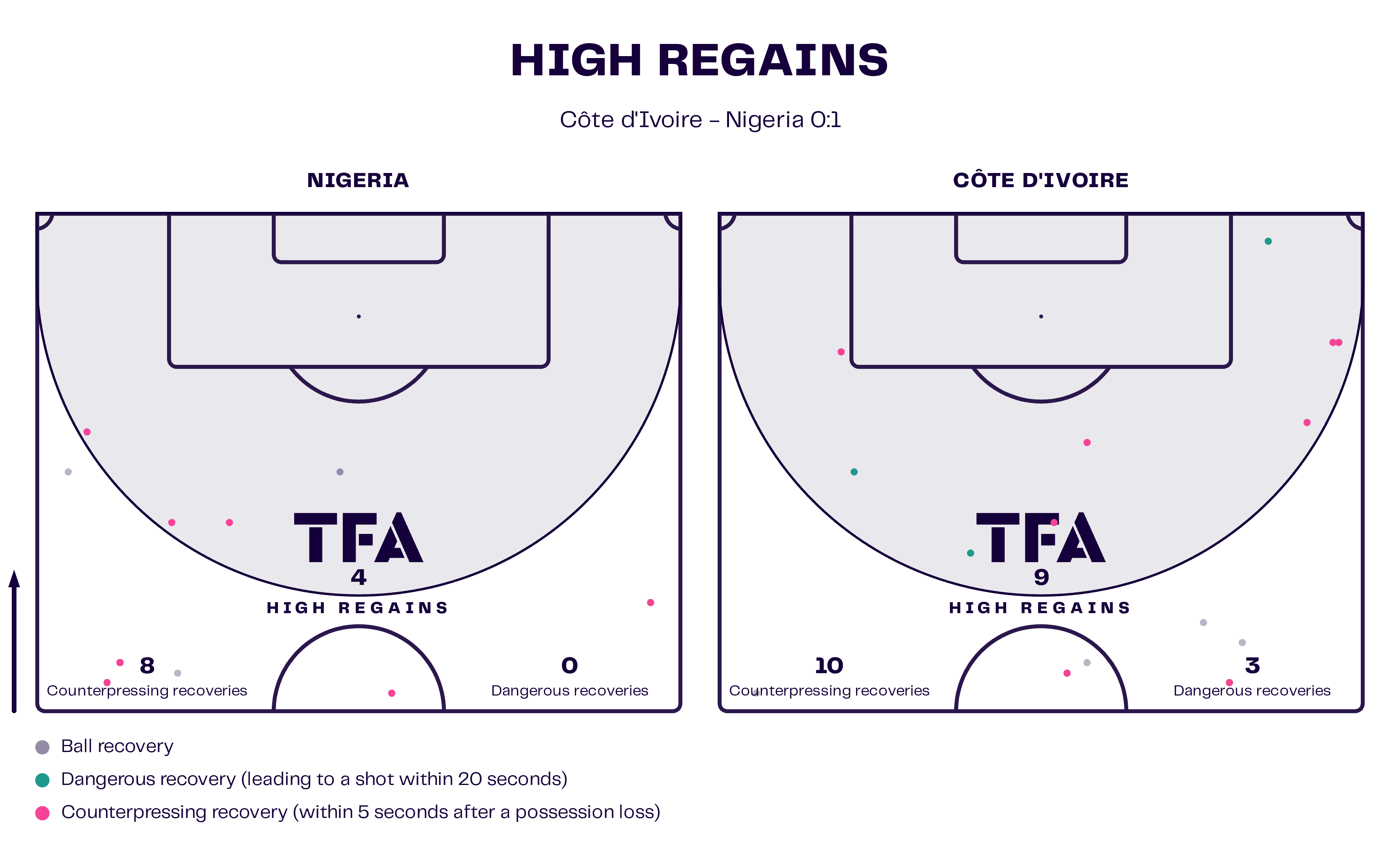
While we can expect Nigeria to defend a bit deeper, I’d expect Ivory Coast to try and use their high press as a major tool in Sunday’s game, both for stifling Nigeria’s progression and also for their own chance creation benefits via the creation of high turnovers.
In their earlier meeting in the tournament, Ivory Coast made more than twice as many high regains as Nigeria, three of them being ‘dangerous recoveries’ which led to a shot within 20 seconds of the turnover.
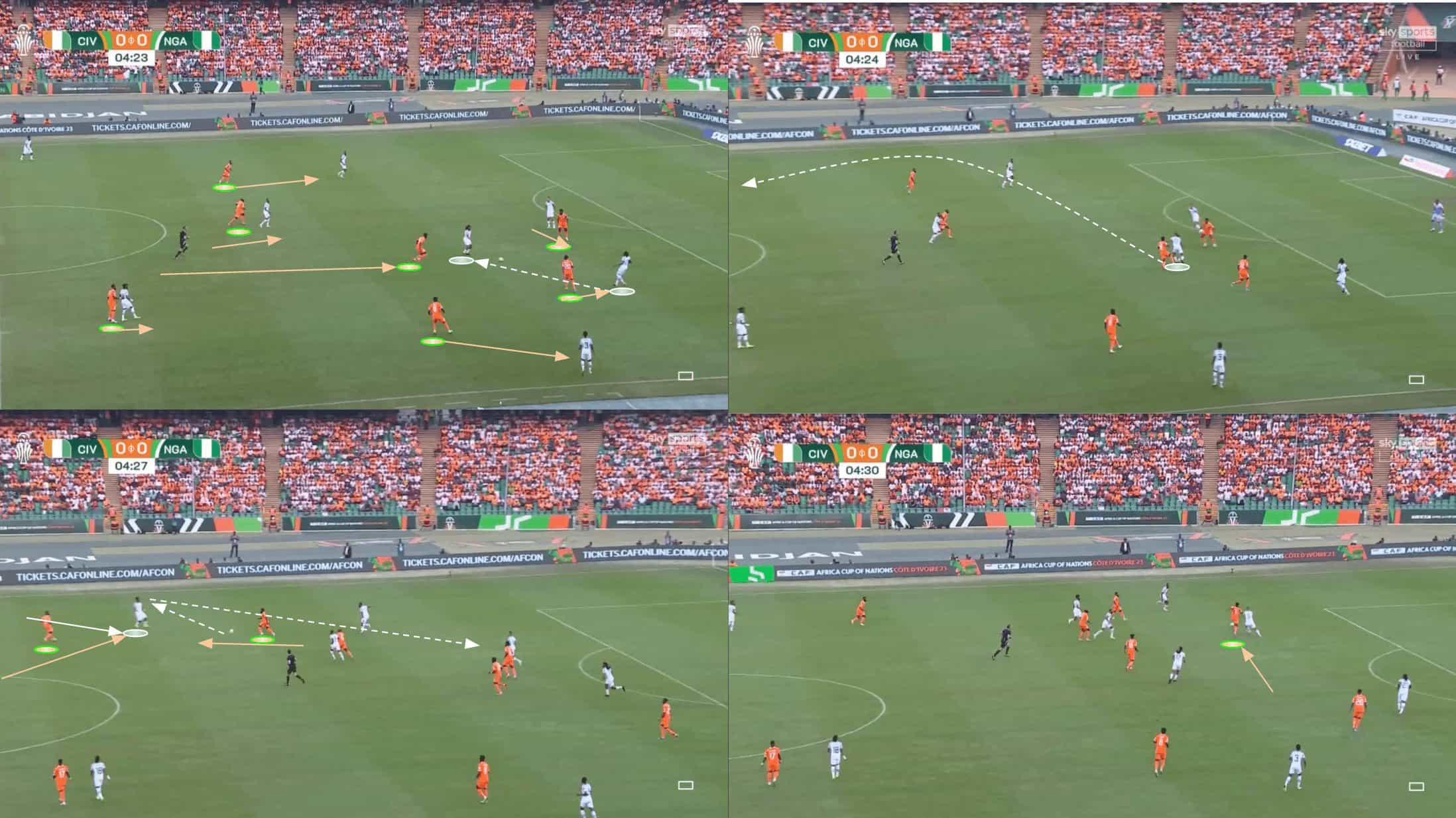
Here, as Nigeria play the ball to the central midfielder who drops off — Iwobi, in this case — the midfielder is prevented from turning fully by aggressive pressure from Ivory Coast’s midfield. Furthermore, the Ivorians’ attack also picks up the near passing options to the Nigerian receiver, leaving him no real option but to play a risky ball out while turning.
The pass does actually meet a teammate but that player too comes under immediate pressure from behind, preventing him from doing much but play the ball back, which gives Ivory Coast an excellent opportunity to force the turnover and attack Nigeria’s goal from high.
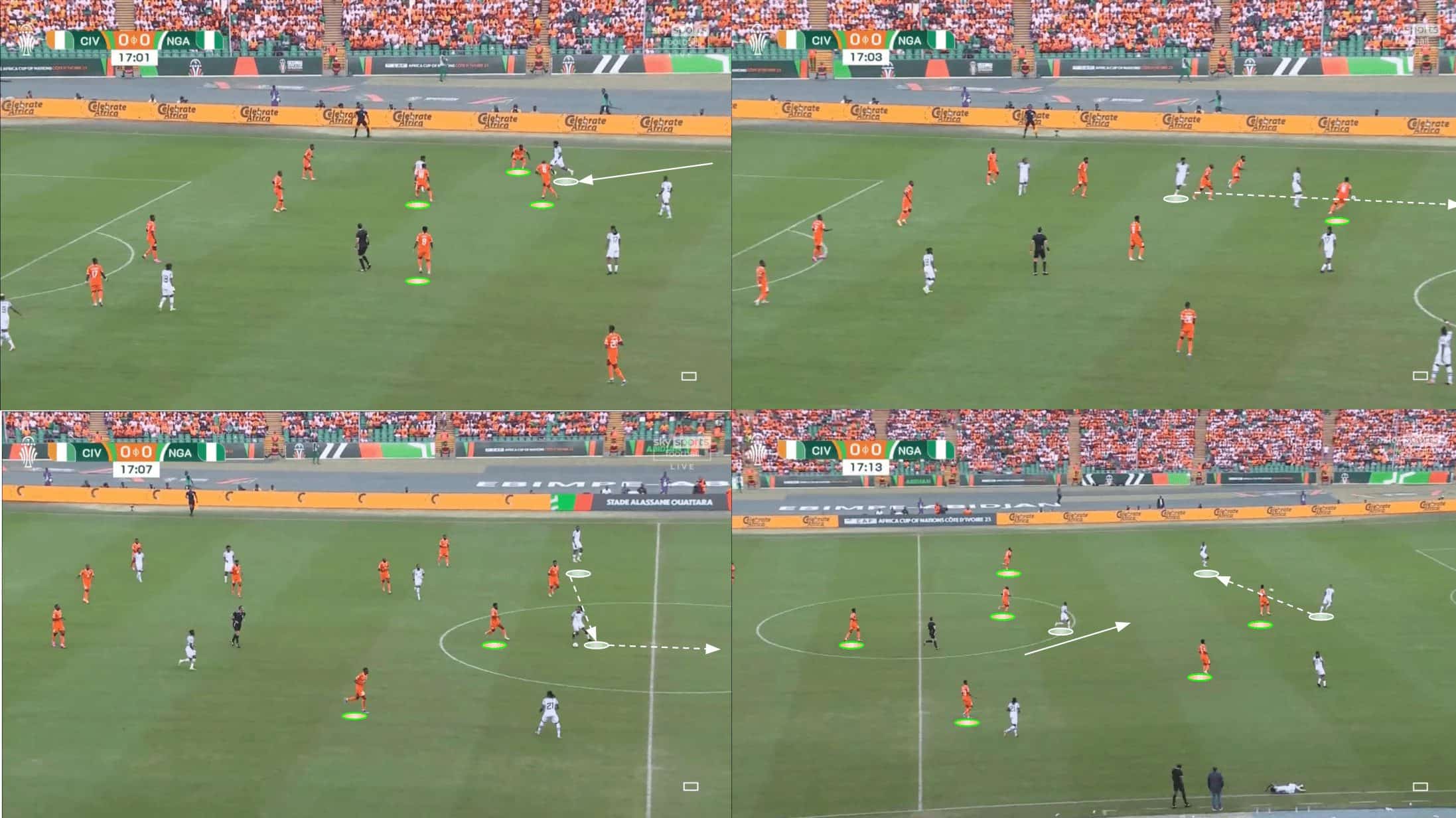
In another instance, here we see Nigeria making their way forward on the right, which attracts a lot of intense pressure around the ball carrier from Ivory Coast. This prevents the ball carrier from finding a path through on the right, so he’s forced to go back which only leads to more intense pressure as Ivory Coast advance as a unit every time, continuously ensuring the new Nigerian receiver and all their nearest passing options are covered all the time.
This helps the Elephants gain a lot of ground as they force Nigeria back and end up in a good position to execute a higher press, which could result in a dangerous recovery.
This passage of play highlights some brilliant defensive fundamentals from a pressing perspective, none moreso than the unity and togetherness with which the defensive side presses and shifts forward, ensuring Nigeria can’t find a way through and they keep the pressure high.
Suppose Ivory Coast can press in this fashion on Sunday. In that case, they’ll present a formidable out-of-possession threat to this strong Nigerian side and potentially cause some counterattacking problems as a result.
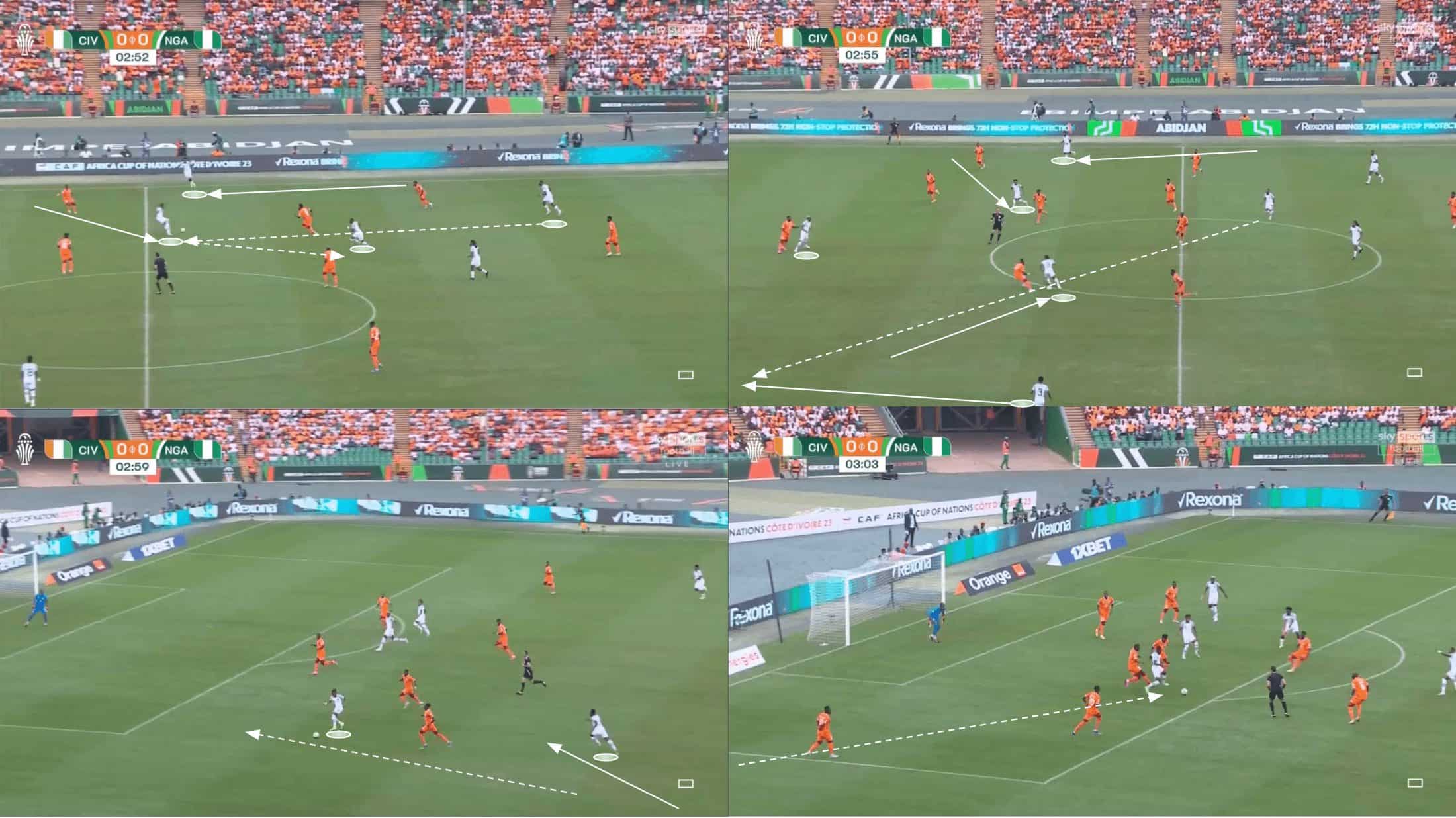
Our next image provides a more positive example of Nigeria’s attack and demonstrates where they could expect to experience more joy on Sunday. Any attack in which they’re given space to run in behind the Ivorian defence will be a dangerous one. The Super Eagles will constantly be looking to exploit space out wide behind Ivory Coast’s aggressive full-backs in the chance creation phase as well as centrally in behind the centre-backs on the counter.
In their previous meeting, Nigeria registered four counterattacks versus Ivory Coast, a joint-tournament high for Peseiro’s men. Transitions to attack will be a vital attacking outlet for them once again in the final.
In this case, above, we see how the wide attackers’ narrow positioning in the half-spaces has proven vital to Nigeria’s attacking prowess during this tournament. In this instance, Ajayi drives the ball forward to Chukwueze in the right half-space while Aina overlaps out wide on the right.
Chukwueze plays the ball back into the centre for Onyeka, who can progress through Lookman, who dummies it in the left half-space, allowing the ball to run through for Zaidu Sanusi, overlapping on the left.
Here, the final ball is lacking, so the attack comes to nothing. Nigeria will have to be brave and ambitious in the final third on Sunday to ensure they make the most of their chances when they come, something they haven’t always done during this tournament thus far.
This attack does provide us with an example of the clear front five their 3-4-3 attacking shape forms, however, with the overlapping wing-backs providing natural width as the wide attackers move into the half-spaces on either side of Osimhen.
This is a contrast to Ivory Coast’s attacking shape, which sees the wingers remain wider, giving the ‘8’s the license to move forward into the half-spaces.
Nigeria will usually have a 3-2 base at the back in the form of their three centre-backs and two central midfielders who will remain fairly central and sturdy, providing security for any potential transitional attacks that need defending, while Ivory Coast may commit as many as seven bodies forward at times, leaving them more open to Nigeria’s lethal counterattacks.
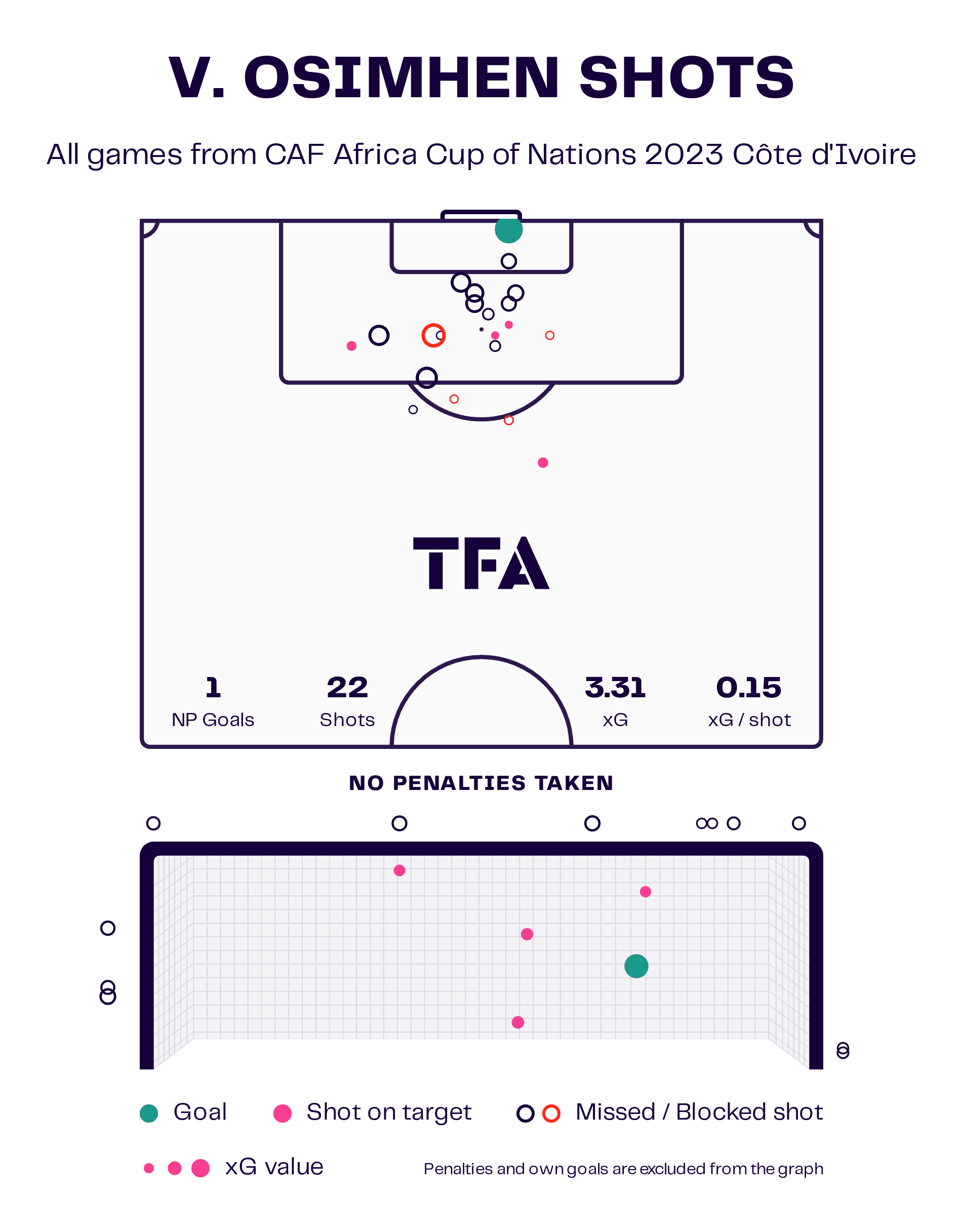
Napoli’s Victor Osimhen will look to exploit the space behind Ivory Coast’s backline from a central position as well as get on the end of cutback balls and crosses into the danger zone. Still, he’ll need to be more clinical than he’s been in this tournament so far in order to ensure his team’s glory.
So far, the world class striker has scored just one from 22 shots and 3.31 xG. It’s true that this viz shows us he’s getting into the right positions and generating plenty of chances, which is very positive. However, in a tournament, results are needed in the short term and at present, Osimhen hasn’t delivered what his team will have hoped for thus far.
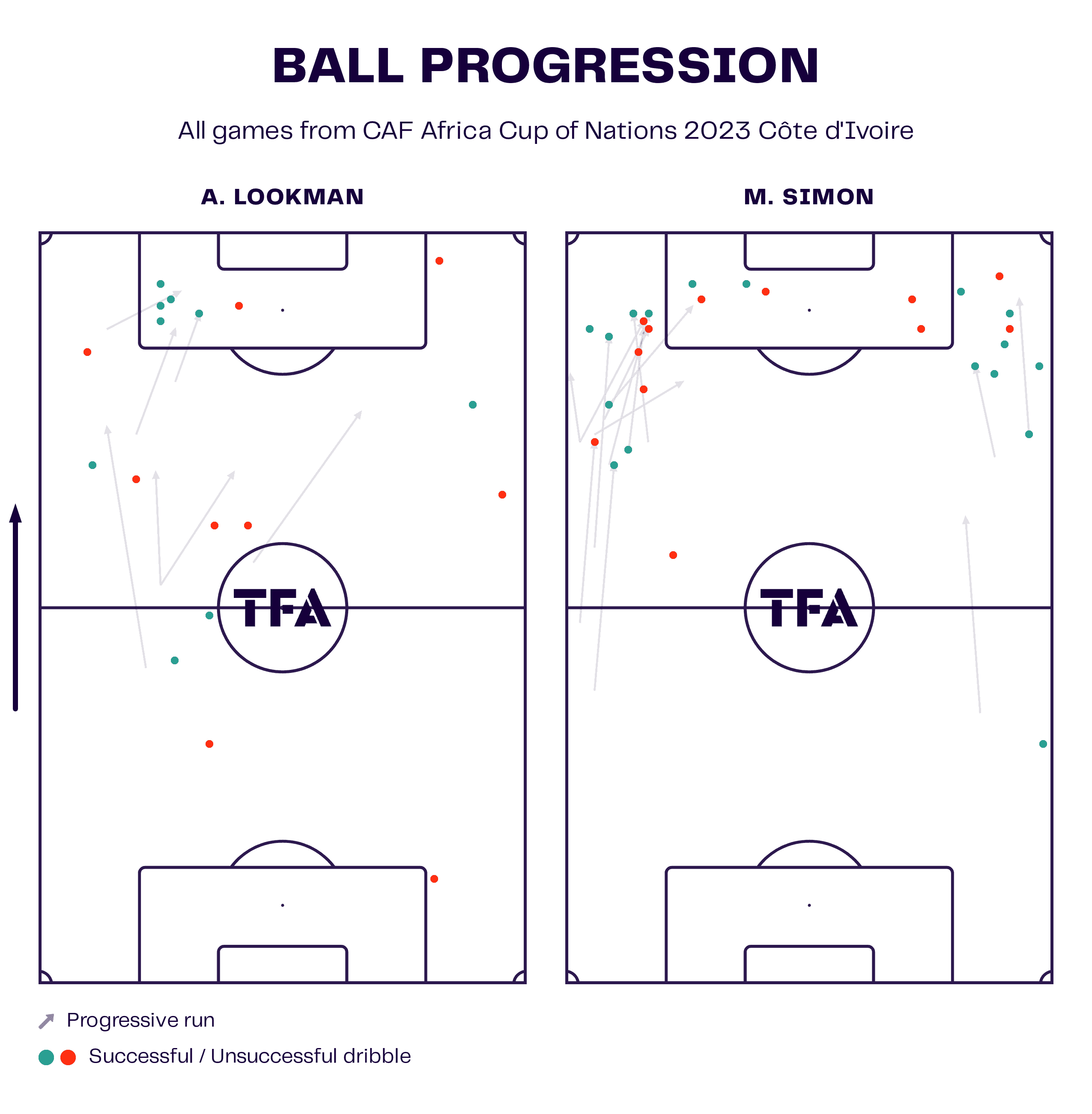
Lastly, Nigeria’s wide attackers, like Ivory Coast’s, will provide a significant threat via their dribbling qualities and creative passing abilities. Additionally, as his team’s top scorer in the tournament so far, expect Lookman to threaten the opposition’s goal in the final.
The main difference between these attackers and those of Ivory Coast are the positions from which you’ll see them attacking. They will be narrower and more central than the Ivorian wide attackers, who will look to attack the box from wider areas, though you may find Simon attacking from slightly wider than Lookman.
Conclusion
To conclude this tactical analysis and preview for the AFCON 2023 final, we expect Ivory Coast to have more of the ball in this game and Nigeria to be comfortable playing without the ball, relying mainly on their counterattacking as a critical offensive tool.
Ivory Coast’s high press will be a valuable tool for them, as well as their attacking ‘8’s and wide threats.
Similarly, Nigeria’s wingers will also pose a major attacking threat to the opposition, along with their wing-backs and the ball progression threat of Calvin Bassey, which Ivory Coast will have to prepare to deal with.





Comments